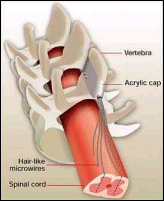Intraspinal microstimulation (ISMS)

Spinal cord injuries disrupt the communication between the brain and the nerves leading to muscles. Networks of neurons in the spinal cord below the level of the injury remain more or less intact. It is therefore theoretically possible to restore some function following spinal cord injury by artificially activating these surviving neurons. We have been working on techniques for generating functional movements by electrically stimulating the spinal cord through microwires finer than a human hair. Unfortunately microwires implanted manually are very difficult to target accurately and tend to migrate over days and weeks. In my opinion intraspinal microstimulation will not be a clinically viable technique until these difficulties are overcome.
Recent Papers:
MUSHAHWAR, V. K., & HORCH, K. W. 1997. Proposed specifications for a lumbar spinal cord electrode array for control of lower extremities in paraplegia. IEEE Transactions on Rehabilitation Engineering 15: 237-243.
MUSHAHWAR, V., COLLINS, D.F. & PROCHAZKA, A. (2000) Spinal cord microstimulation generates functional limb movements. Experimental Neurology, 163, 422-429.
Related Files:
PROCHAZKA, A., MUSHAHWAR, V.K. & MCCREERY, D.B. (2001) Neural prostheses. Journal of Physiology, 533, 99-109